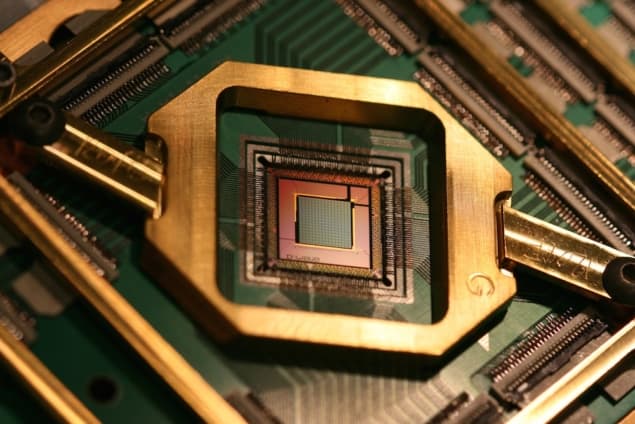Lorenzo Buffoni and Michele Campisi of Italy’s University of Florence have studied the thermodynamics of the D-Wave 2000Q quantum processor – which comprises 2000 interconnected superconducting circuits that each serve as a quantum bit (qubit). Here they tell Physics World what motivated them to study “reverse annealing” on the processor and how their results could lead to an improvement of how calculations are done on the D-Wave processor.

Why is important to study the thermodynamics of D-Wave quantum processors?
Michele Campisi: Quantum technology has just entered the “noisy intermediate-scale quantum” (NISQ) era. This is characterized by the ability to fabricate hardware with hundreds or even thousands (in the case of D-Wave) of qubits, but also the inability to control the qubits with the degree of accuracy and fidelity that is necessary to accomplish fault-tolerant quantum computations.
One of the main obstacles on the path to fault-tolerant quantum computations is noise – for example, the thermal noise that results from the interaction of the qubits with the substrate on which they are patterned. Understanding and quantifying the thermal phenomena that accompany the operation of a NISQ device is therefore crucial in the present stage of their development.
What is reverse annealing?
Lorenzo Buffoni: In a generic annealing process, you slowly drive a quantum device so as to change in time the Hamiltonian that describes its dynamics. In forward annealing you start from some Hamiltonian, call it Hx, and end-up at some other Hamiltonian, say Hz, that does not commute with Hx. The presence of non-commuting terms during the evolution results in purely quantum phenomena, such as quantum tunnelling.
In reverse annealing you start with Hz; then turn on an external control field to introduce an Hx term in the Hamilitonian (thus causing quantum dynamics); and then you go back to Hz. Such reverse annealing protocols have been recently added to the set of operations that can be run on D-Wave because they can be used to perform local searches in the neighbourhood of a solution encoded in an eigenstate of Hz. We chose to do reverse annealing because it is the only choice for which the D-Wave interface gives you full freedom to prepare any eigenstate of your initial Hamiltonian (Hz, in our case) and that was a crucial requirement for our experiments.
How did you perform your experiments using D-Wave’s Leap service?
LB: With D-Wave’s Leap service, virtually everyone can access one of the quantum annealers that D-Wave hosts locally via a cloud service. The devices can be programmed using D-Wave’s own APIs, which are easy to embed in a Python script. The APIs are well documented, and D-Wave provides a variety of examples and demos to get started.
Once you have programmed your own experiment, the script running on your computer automatically connects to the selected D-Wave quantum annealer, runs your programs on it, and gives the program output back to your computer, all in a matter of seconds. For those interested in the implementation details of our experiments and/or willing to try out this service, we have open-sourced our code.
You conclude that the D-Wave system acts as a “thermal accelerator”, what do you mean by this?
LB: In order to characterize the device from a thermodynamic point of view we have prepared it in a hot (high-temperature) state. Then we have studied how much energy it exchanges in the form of work — exchanged with the external control electrical fields– and in the form of heat, which is exchanged with the cold chip substrate.
Thermodynamics allows only four possible ways for this to occur:
- The device gives away energy both to the work source and to the cold thermal source: that is what standard heat engines do
- The device receives energy both from the work source and from the cold substrate: in that case it would function as a refrigerator
- Both the device and the cold substrate gain energy from the work source, so the device operates as a “heater”
- The hot device loses energy to the cold substrate, while the work source spends energy to accelerate that natural energy flow, hence the expression “thermal accelerator”
MC: It is important to stress that how to precisely quantify the actual heat and work involved during the operation of the D-Wave processor is a challenging, yet unsolved, problem. However, by using recent results in non-equilibrium thermodynamics, we were able to put quantitative bounds on the heat and work, and that was sufficient to tell us that thermal acceleration was occurring. Due to its generality, our method can be used in the thermodynamic study of other quantum devices as well.
Does you research have any implications for how D-Wave systems are used to solve problems?
MC: Our work suggests that in the specific case of D-Wave, thermal noise might indeed be beneficial. In quantum annealing you want the processor to follow a path towards a specific target state. It is very much the same as having to walk from A to B while holding a pendulum and you want to reach B without setting the pendulum into oscillation. The D-wave strategy is to achieve that by walking very slowly.
Imagine however that you are now walking through a very viscous fluid, you spend now more energy to walk through it, but it is easier to prevent the pendulum from oscillating, because oscillations are quickly dumped. That is indeed what we have observed in our experiments. We have thus learned that in designing optimal annealing paths, it might be useful to go through the more “viscous” regions, you pay an energetic cost to traverse them, but you might be able to do that faster, and more reliably. Hopefully, our work will trigger further investigation in this new direction.
Buffoni and Campisi describe their research in Quantum Science and Technology.



